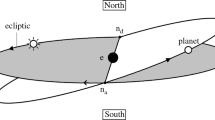Abstract
Based on the motion of nearly parabolic comets, we have improved the position of planet X in its orbit obtained by Batygin and Brown (2016). By assuming that some of the comets discovered to date could have close encounters with this planet, we have determined the comets with a small minimum orbit intersection distance with the planet. Five comets having hyperbolic orbits before their entry into the inner Solar system have been separated out from the general list. By assuming that at least one of them had a close encounter with the planet, we have determined the planet’s possible position. The planet’s probable ephemeris positions at the present epoch have been obtained by assuming the planet to have prograde and retrograde motions. In the case of a prograde motion, the planet is currently at a distance Δ whose value belongs to the interval Δ ∈ (1110, 1120) AU and has a right ascension α and declination δ within the intervals α ∈ (83◦, 90◦) and δ ∈ (8◦, 10◦); the true anomaly υ belongs to the interval υ ∈ (176◦, 184◦). In the case of a retrograde motion: α ∈ (48◦, 58◦), δ ∈ (−12◦, −6◦), Δ ∈ (790, 910) AU, and υ ∈ (212◦, 223◦). It should be noted that in the case of a retrograde motion of the planet, its ephemeris position obtained from the motion of comets agrees with the planet’s position obtained byHolman and Payne (2016) from highly accurate Cassini observations and is consistent with the results of Fienga et al. (2016).
Similar content being viewed by others
References
V. K. Abalakin, E. P. Aksenov, E. A. Grebenikov, V. G. Demin, and Yu. A. Ryabov, Reference Manual on Celestial Mechanics and Astrodynamics (Nauka, Moscow, 1976), p. 865 [in Russian].
K. Batygin and M. E. Brown, Astron. J. 151, 22 (2016).
Yu. S. Bondarenko, Halley Electronic Ephemeris of Comets. www.ipa.nw.ru/halley. Accessed 2016.
Yu.S. Bondarenko, Yu.D. Medvedev, and P. P. Yas’ko, Tr. IPA RAN, No. 23, 172 (2012).
A. Fienga, J. Laskar, H. Manche, and M. Gastineau, Astron. Astrophys. 587, L8 (2016).
A. S. Guliev, Kinem. Fiz. Neb. Tel 11, 44 (1994).
M. Holman and M. Payne, arXiv:1604.03180v1 [astro-ph.EP] 13 Apr (2016).
JPL. http://ssd.jpl.nasa.gov/sbdb.cgi. Accessed 2016.
K. J. Meech, O. R. Hainaut, and B. G. Marsden, Minor Bodies in the Outer Solar System, Ed. by A. Fitzsimmons et al. (Springer, 2000), p.75.
The List of Split Comets. http://www.icq.eps.harvard.edu/ICQsplit.html, Accessed 2016.
Author information
Authors and Affiliations
Corresponding author
Additional information
Original Russian Text © Yu.D. Medvedev, D.E. Vavilov, Yu.S. Bondarenko, D.A. Bulekbaev, N.B. Kunturova, 2017, published in Pis’ma v Astronomicheskii Zhurnal, 2017, Vol. 43, No. 2, pp. 143–148.
Rights and permissions
About this article
Cite this article
Medvedev, Y.D., Vavilov, D.E., Bondarenko, Y.S. et al. Improvement of the position of planet X based on the motion of nearly parabolic comets. Astron. Lett. 43, 120–125 (2017). https://doi.org/10.1134/S1063773717020037
Received:
Published:
Issue Date:
DOI: https://doi.org/10.1134/S1063773717020037




